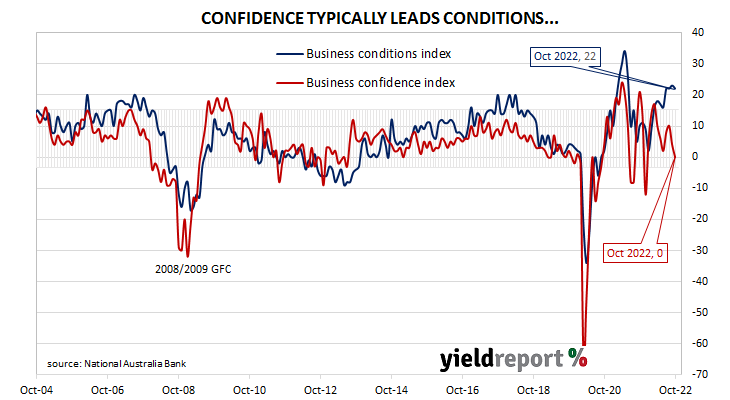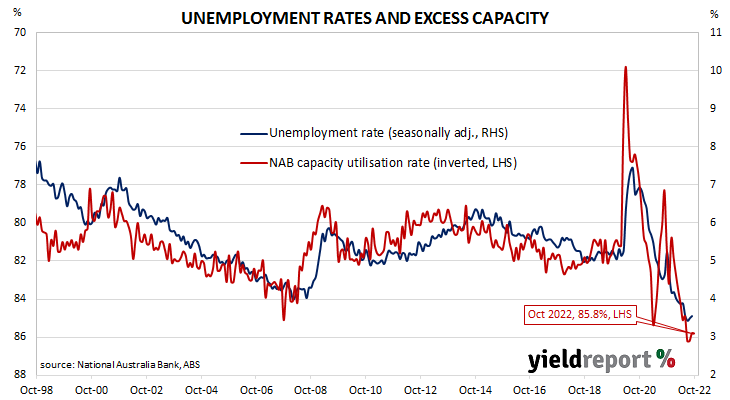Summary: Business conditions deteriorate a touch in October; conditions “fairly robust” across states, sectors; confidence deteriorates, below long-term average; as many firms pessimistic as optimistic; ANZ: “strong result” reinforces need for RBA to raise cash rate to restrictive level; capacity utilisation rate steady, all 8 sectors of economy still above respective long-run averages.
NAB’s business survey indicated Australian business conditions were robust in the first half of 2018, with a cyclical-peak reached in April of that year. Readings from NAB’s index then began to slip and forecasts of a slowdown in the domestic economy began to emerge in the first half of 2019 as the index trended lower. It hit a nadir in April 2020 as pandemic restrictions were introduced but then conditions improved markedly over the next twelve months. Readings have been generally in a historically-normal range since then.
According to NAB’s latest monthly business survey of over 400 firms conducted over the last week of October, business conditions have deteriorated a touch, albeit to a still-elevated level. NAB’s conditions index registered 22, down 1 from September’s revised reading of 23.
“Conditions remain fairly robust across the states and across sectors,” said NAB Chief Economist Alan Oster. “There was something of a correction in wholesale and retail conditions this month from very high readings in the previous survey but they both remain at very strong levels, as do conditions in mining, transport and utilities and recreation and personal services.”
Business confidence also deteriorated. NAB’s confidence index fell from September’s revised reading of 4 to 0, a reading which is below the long-term average. Typically, NAB’s confidence index leads the conditions index by one month, although some divergences have appeared from time to time.
“Confidence is now below the long-run average at 0 index points, which effectively means that just as many firms in our survey are pessimistic as optimistic,” noted Oster.
Commonwealth Government bond yields moved substantially higher on the day, outpacing the overnight rises of their US Treasury counterparts. By the close of business, the 3-year ACGB yield had gained 14bps to 3.56% while 10-year and 20-year yield both finished 13bps higher at 4.05% and 4.40% respectively.
In the cash futures market, expectations regarding future rate rises firmed. At the end of the day, contracts implied the cash rate would rise from the current rate of 2.81% to average 2.995% in December and then increase to an average of 3.225% in February. May 2023 contracts implied a 3.815% average cash rate while August 2023 contracts implied 4.15%.
“Business conditions are still very strong, capacity utilisation is barely off its peak and cost and price growth remains elevated…” said ANZ economist Madeline Dunk. “We think the strong result reinforces the need for the RBA to take the cash rate to a restrictive 3.85% next year.”
NAB’s measure of national capacity utilisation remained at a historically-elevated level as it held steady at 85.8%. All eight sectors of the economy were reported to be operating above their respective long-run averages.
Capacity utilisation is generally accepted as an indicator of future investment expenditure and it also has a strong inverse relationship with the unemployment rate.



